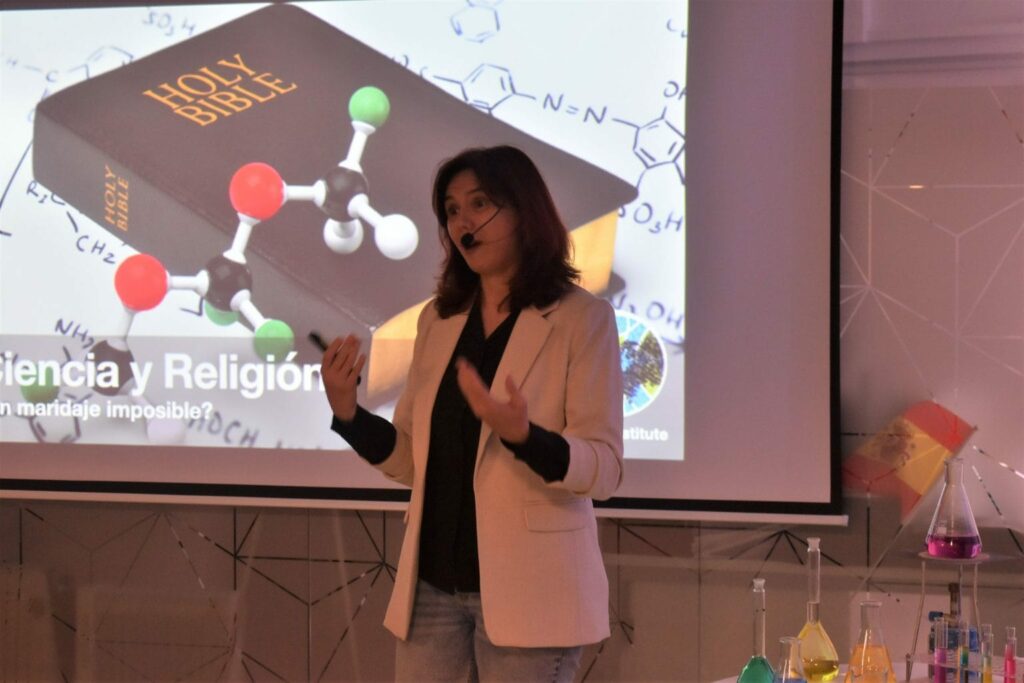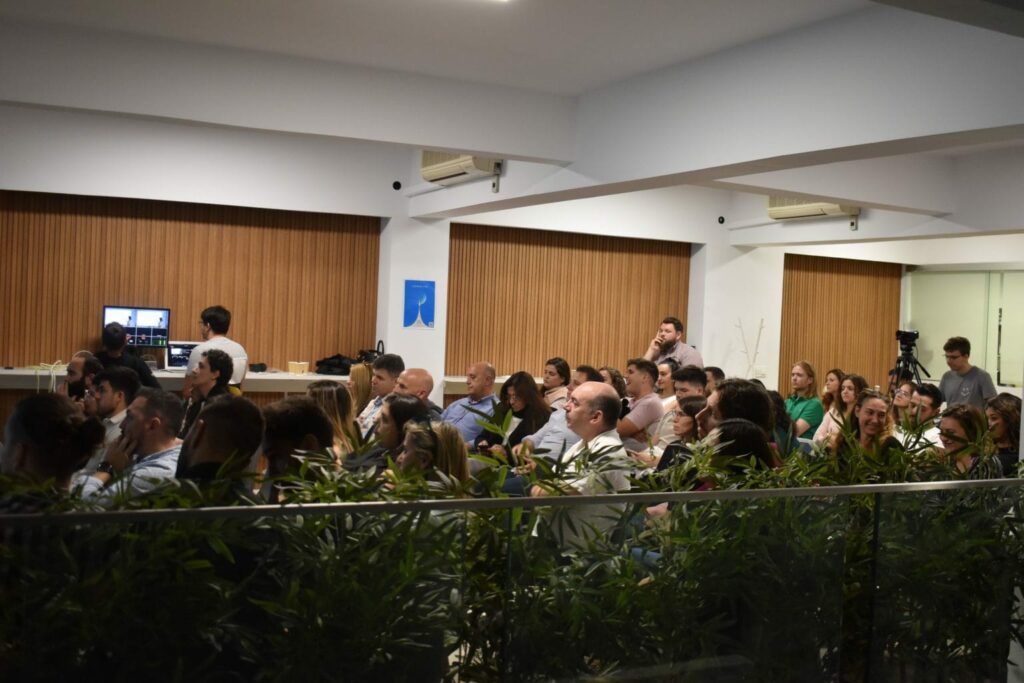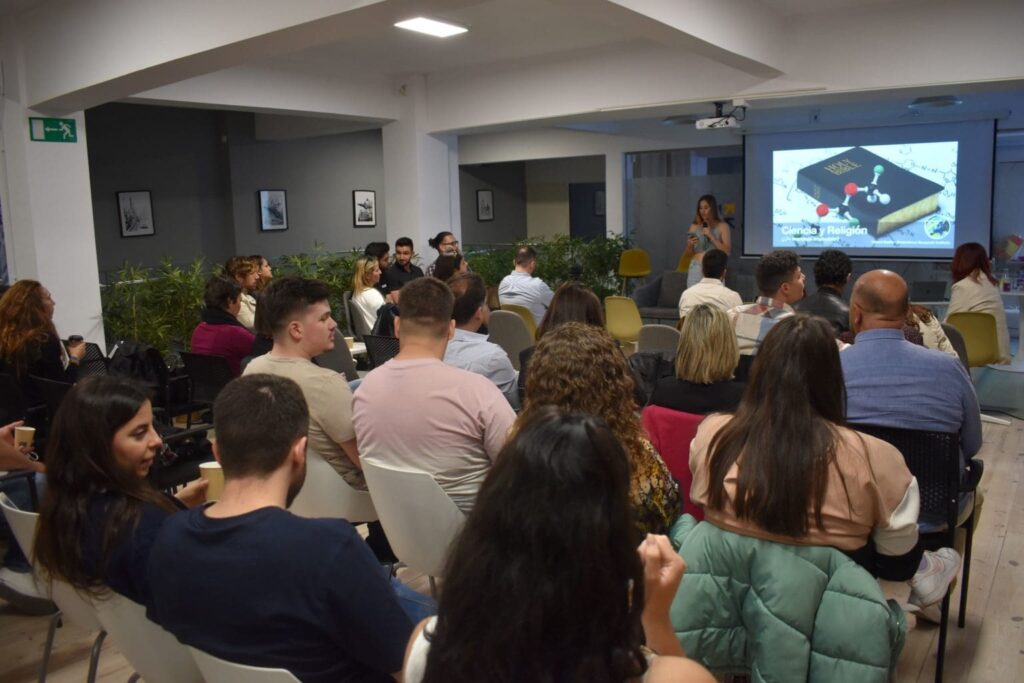Can Science and Religion Go Together? Yes, Adventist Scientist Says
Noemí Durán’s presentation for a secular audience in Madrid, Spain, explains why.
June 10, 2023 | Marcos Paseggi, Adventist Review
“Science or religion. It’s not either/or. There’s no need to choose one or the other,” Seventh-day Adventist scientist Noemí Durán said, in a presentation to a Christian and secular public at a venue in downtown Madrid, Spain, May 20. Her talk, titled “Science and Religion: An Unlikely Pairing?” was sponsored by Iglesia CERO, an Adventist congregation that caters to a mostly secular, urban demographic.
Durán is director of the European branch of the Geoscience Research Institute. She is also an experienced biologist interested in the interactions between biblical faith and current scientific developments, particularly when it comes to origins of life and human beings. Against that background, she doesn’t see a conflict between her faith and her scientific endeavors. “Noemí Durán, the scientist, is the same person as Noemí Durán, the Christian,” she said. “Not only that. As a scientist and a Christian, Noemí Durán is also a creationist. Many people have a hard time understanding that.”

Seventh-day Adventist scientist Noemí Durán (center) chats with some of the participants before her May 20 talk on the tensions and connections between science and religion. [Photo: Marcos Paseggi, Adventist Review]
Are Science and Religion Incompatible?
There are words that one naturally connects to science —reality, empirical, objective — and religion — supernatural, personal experience, subjective. Typically, it is only science that is labeled as empirical, but this is not necessarily so.
After providing some examples from the Bible, Durán said, “The God I believe in is much more empirical than what usually appears reflected in our understanding of religion.”
Durán also explained to her audience that science is usually not as objective as it claims to be. “There’s a belief that, as scientists, we are objective. We do not allow our opinions and feelings but that’s a lie. We are people just like anybody else, and we are informed by our ideas, expectations, and desires for an outcome.”

Noemí Durán presents on “Science and Religion: An Impossible Pairing?” in Madrid, Spain, on May 20. [Photo: Marcos Paseggi, Adventist Review]
Science and the Supernatural
The very notion of the supernatural changes with time, Durán said. “Sometimes, we describe as supernatural those elements that we cannot explain with the natural laws we currently know,” she said. “Currently, there are phenomena that we believe are real, because they result from observation, but we don’t really know how they work, at least not yet.”
Nowadays, the scientific community accepts phenomena that, not many years ago, would have been used to mock people advocating them, Durán said. She mentioned current scientific discussions that delve into the possibility that life on this planet resulted from extra-terrestrial activity. And, given the statistical unlikelihood of planet Earth, where physical constants — speed of light, gravitational constant, etc. — coincide in such a way that make life possible, scientists at respected events are discussing the possibility of multiple universes.
“I just share this to show that the notion of the objectivity of science is actually quite subjective,” Durán said.

Some of the public that attended Noemí Durán’s presentation on science and religion on May 20. They include Iglesia CERO members and secular, non-Christian guests. [Photo: Marcos Paseggi, Adventist Review]
According to several authors, modern science was a by-product of Christian theology. Quoting professor Antonio Fernández Rañada, she explained that “science is based on the Christian belief of a God that not only created the cosmos but also gave it some order and made it to follow certain laws…. The world has an order that allows it to be an object of study.”
Durán reminded her audience that those 16th- and 17th-century revolutionaries of science were also committed Christians, including Francis Bacon, Isaac Newton, and Michael Faraday.
Where does enmity between the two come from? Durán explained how, in the context of a predominant Christian belief that changes in species are not possible, Charles Darwin set out to show that species do, in fact, change over time. He also began to advocate for a common ancestor for all species.
“The scientific community of the day was eager to embrace Darwin because they were waiting for such an opportunity — to get rid of the church’s oppression of them,” she said.

Durán’s presentations usually include some experiments to drive key points home. [Photo: Marcos Paseggi, Adventist Review]
Nowadays, she explained, a naturalist explanation is accepted a priori even against logic and common sense. She quoted the late evolutionist biologist Richard Lewontin, who stated, “Our willingness to accept scientific claims that are against common sense is the key to an understanding of the real struggle between science and the supernatural. We take the side of science in spite of the patent absurdity of some of its constructs, in spite of its failure to fulfill many of its extravagant promises of health and life, in spite of the tolerance of the scientific community for unsubstantiated just-so stories, because we have a prior commitment, a commitment to materialism…. That materialism is absolute, for we cannot allow a Divine Foot in the door.”
The Ultimate Goal of Science
But what is the ultimate goal of science? Durán asked. According to evolutionist scientist Richard Dawkins, for instance, “science is the disinterested search for the objective truth about the material world.”
Against that background, Durán suggested that any search for scientific truth should keep an open mind, favoring an out-of-the-box mentality. “There was a time when thinking outside of the box meant to consider the non-existence of God,” she said. “Nowadays, thinking outside of the box is suggesting that God actually exists. So, we need to keep our options open and follow evidence wherever it may take us.”

A young Iglesia CERO member introduces Noemí Durán at a downtown Madrid, Spain, venue on May 20. [Photo: Marcos Paseggi, Adventist Review]
Durán explained that atheist and Christian scientists work in a very similar way as they follow the accepted methods of observation and scientific analysis. “It is only when they face the ‘singularity’ of a phenomenon — an event that may have happened only once — that they come up with diverging explanations.”
In that sense, Durán advised any scientist or person in search of truth to keep all their options open, analyze evidence, and then choose the conclusion that best agrees with them, and to acknowledge that they might be wrong about a particular issue and need to change.
A Scientist and a Believer
In the last part of her presentation, Durán shared some of the elements that have helped her to choose being a scientist and a believer at the same time. She mentioned biomimetics (systems or machines that have functions that mimic biological processes), molecular machines (natural or synthetic molecules that convert chemical energy into mechanical forces and motion), and animal altruism.
“All of this helps me to be a believer,” Durán said. “What the Bible says, that God created a perfect world where all interactions were based on love, fits very well with my observations of the natural world.”